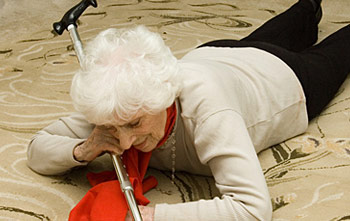
Managing Falls In the Nursing Home: Who, Why and What Next?
For a complete list of accreditations for this course, please see the accreditation information box below the author’s bio. All states recognize our courses for accredited continuing nursing education, CNE, contact hours.
Every day, in nursing homes located throughout the United States, hundreds of residents will experience one or more falls. Are some of these residents individuals that you provide care for on a daily basis? The answer is probably yes. Prevention of falls, whether causing injury or not, is a key safety issue in nursing homes.
For many years, it was assumed that falls were unavoidable accidents, due to just being old, and that nothing, apart from restricting a resident’s mobility or placing them in physical restraints, could be done to prevent falls. Over the past several years, however, interest in fall prevention flourished and, as a result, our thinking about falls has dramatically changed. We now have a better understanding of why falls occur and, more importantly, what can be done to prevent falls from happening. We also now know that falls are not caused by old age itself. But rather, as you will learn, falls have known causes, such as physical illness, medications, and environmental hazards. The biggest lesson we have learned, however, is that while falls may occur often, falls can never be accepted as ordinary events, since there is a great deal that we can do to prevent them. Knowing why a resident may be a fall risk and what can be done to prevent them from falling is an important aspect in managing falls in the nursing home.
Questions? Check out our FAQs page and How Online IV Certification Works!
Objectives
Upon completion of the course, the participant should be able to:
- Identify how frequently falls occur and what harmful consequences may follow an episode of falling.
- Recognize the different causes of falling and which residents are at higher risk.
- State the steps that can be taken to prevent falls from occurring.
- Identify steps to assist the resident that has fallen, in preventing future falls.
Curriculum
Chapter 1: Facts About Falls
- How Frequent are Falls?
- Where and When do Falls Occur?
- How Serious are Falls?
- What is a Fall?
- Why do Residents Fall?
- Internal Risk factors
- External Risk Factors
- How to Identify Residents at Fall Risk?
- Communicating Fall Risk
- Care Planning for Fall Risk
- Monitoring Fall Risk
- Post-Fall Assessments
- Interventions Aimed at Preventing Falls
- Medical Strategies
- Rehabilitative Strategies
- Environmental Strategies
- Confused Residents
- Incontinent Residents
- Hypotensive Residents
- Residents with Neurological and Musculoskeletal Disorders
- California Bill 241
- Implicit Bias in Healthcare
- What is Implicit Bias?
- Implications of Implicit Bias in Healthcare
- How to Reduce Implicit Bias
Price: $48.00
Contact Hours: 4

Course Author

Rein Tideiksaar
Rein Tideiksaar, PhD, PA-C, or Dr. Rein as he is commonly referred to, is the president of Fall Prevent, LLC, Blackwood, New Jersey, a consulting company that provides educational, legal, and marketing services related to fall prevention in the elderly.
Dr. Tideiksaar is a gerontologist, which is a health care professional who specializes in working with elderly patients, and a geriatric physician's assistant. He has been active in the area of fall prevention for over thirty years.
Course Accreditation
See our Accreditation Statements page to view our accreditation information.